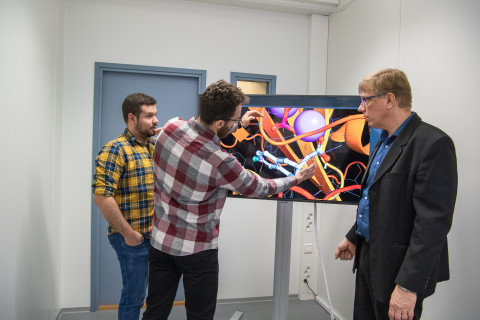Tuberculosis, TB, continues to be a major health concern globally. Every year, 10 million people contract tuberculosis and it is the third most common cause of infection-related death. Patients with antibiotic resistant tuberculosis as well as the various side effects of anti-TB drugs pose challenges to treatment. Professor Antti Poso’s research group is part of an effort seeking to find increasingly efficient and better targeted drugs for tuberculosis.
“In order to minimise the side effects, we need a drug that is more selective in binding to the target protein,” Research Student Magd Badaoui from King's College London explains.
Based in Kuopio, Poso’s research group has developed computer-aided drug design methods for identifying and designing compounds that bind to a specific target. In this case, the group’s focus is on the Ddl enzyme, which plays a crucial role in the development of cell walls in TB bacteria. “Inhibiting the function of this enzyme could significantly weaken the bacteria,” Badaoui says.
Last summer, researchers in Kuopio assisted him in screening out and modelling potential inhibitors. Since then, the virtually selected molecules have been tested in a laboratory in London and, thanks to promising results, Badaoui now continues with computer-aided drug design.
In this work, he is also supported by Postdoctoral Researcher Thales Kronenberger. “This is how drug design typically proceeds: researchers study different compounds by both modelling and experiments in cell cultures, and this guides the development. As the work proceeds, the drug molecule is further modified to better suit the purpose,” Kronenberger says.
Poso points out that the journey of a new drug molecule from the first modelling to clinical use is a long one, typically taking many years and passing through several research groups.
“In our studies, virtual modelling and screening of molecules is done in Kuopio, whereas the biological data is produced in London or Tübingen, for example. An exchange of ideas is also needed in modelling, because things can be done in many different ways.”
Novel antibiotics, cancer and ocular drugs
Poso is Professor of Drug Design at the School of Pharmacy of the University of Eastern Finland, and he is also Distinguished Guest Professor at Tübingen Center for Academic Drug Discovery & Development. Kronenberger works in Poso’s group in Tübingen, specialising in both experimental and computer-aided drug design.
“With this background, it is possible to assess if a molecule is a suitable drug candidate just by looking at it.”
Both Kronenberger and Badaoui have had an opportunity to deepen their expertise in Kuopio, thanks to HPC-Europa-3 funding that is intended for researcher mobility involving high performance computing. In Finland, the programme is coordinated by CSC – IT Centre for Science.
“We started collaborating last summer, when Thales was here on that funding, and it also inspired me to apply for it,” Badaoui says. He is currently writing his doctoral dissertation on the topic in Dr Edina Rosta’s research group at KCL.
In recent years, novel antibiotics that work on resistant bacteria have been developed in the EU-funded INTEGRATE project, which includes research groups and companies from eight different countries. Poso’s research group in Kuopio is responsible for computer-aided design of new drug molecules. Among other things, promising new LsrK kinase inhibitors have been developed in the project. LsrK kinase is a protein that plays a role in bacterial signalling. By inhibiting its function, it might be possible to prevent the growth and spreading of bacteria.
Kronenberger says that back in Tübingen, he makes use of the things he has learnt about antibiotics during his visits to Kuopio. The current mutual interests include the SurA protein, which contributes to the development of cell walls in bacteria and whose elimination seems to make bacteria less contagious and less resistant to antibiotics. According to Poso, inhibiting the function of SurA could work on pseudomonas and coliform bacteria that cause hospital infections, among other things.
“New anti-bacterial drugs share the ability to weaken bacterial function in one way or another. They also enhance the efficiency of traditional antibiotics, when used together.”
Cancer drugs and, more recently, drugs developed for age-related macular degeneration are among the key targets of research of Poso’s group. Together with his German partners, Poso has long been working on a novel drug therapy for liver and pancreatic cancer. “The prognosis of these cancers poor, if surgery is unsuccessful.”
The therapy under development is based on the inhibition of the Rpa protein complex, which seems to reduce cancer growth. The Rpa complex constitutes part of a cellular system that decodes and replicates DNA, and inhibiting its function has major implications for therapy, especially in cancer cells.
The University of Tübingen has secured leading German research cluster funding for exceptionally many fields ranging from artificial intelligence to cancer therapy, and to research on anti-bacterial drugs. “I’m sure that by investing in these fields, we’ve done something right also here in Kuopio,” Poso says.
Image: According to Antti Poso (on the right), drug design is a global field where networking plays a key role. Presently working in Germany, Thales Kronenberger (on the left) graduated from the University of Sao Paulo in Brazil, where Poso’s research group is also launching collaboration. The image on the screen is related to the research project of Magd Badaoui (in the centre) and shows the active site of Ddl protein, with ATP, two Mg2+ ions and a potential inhibitor.
